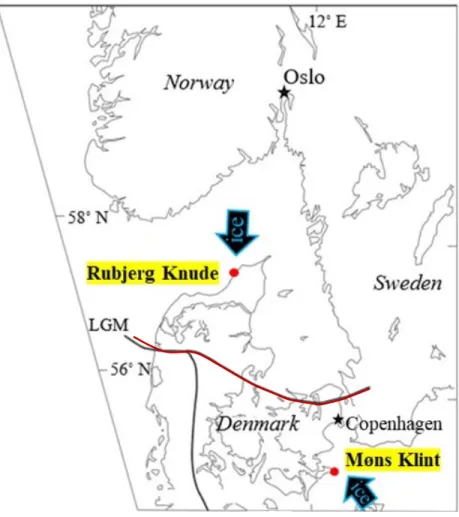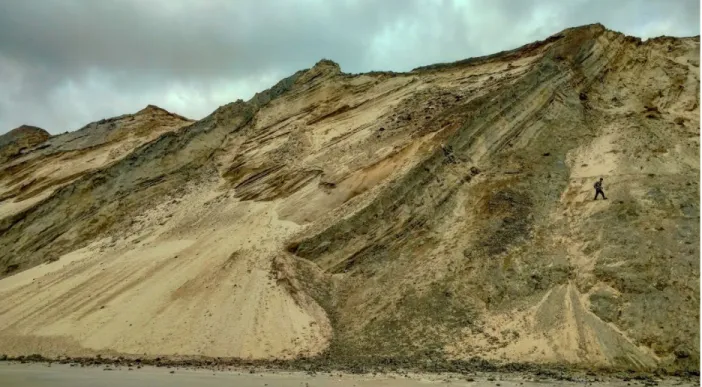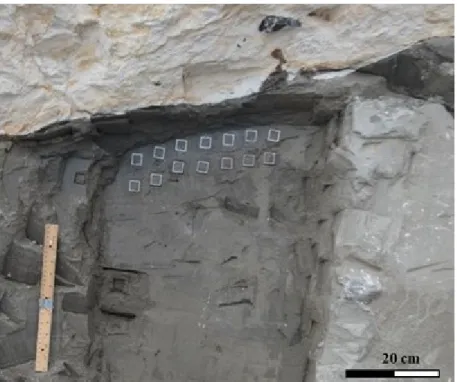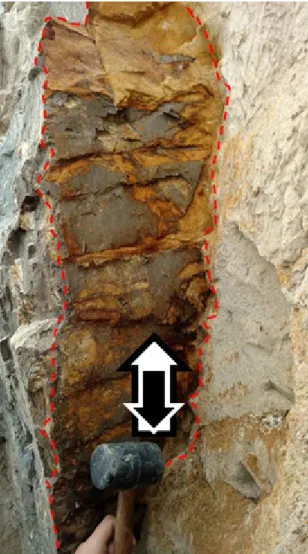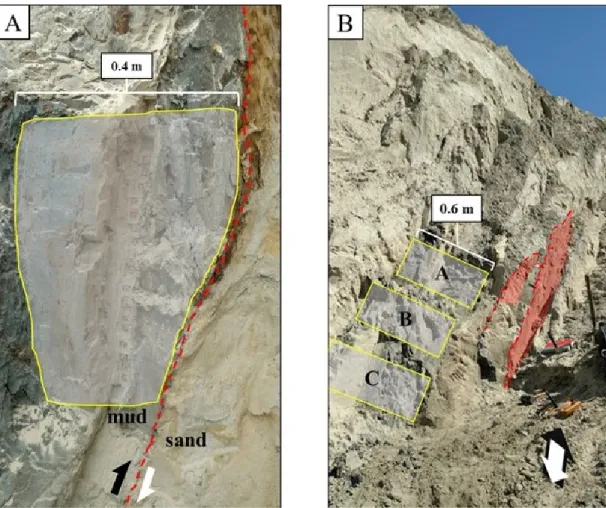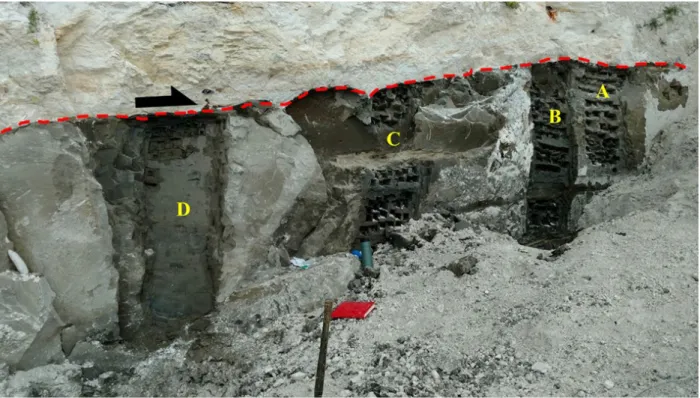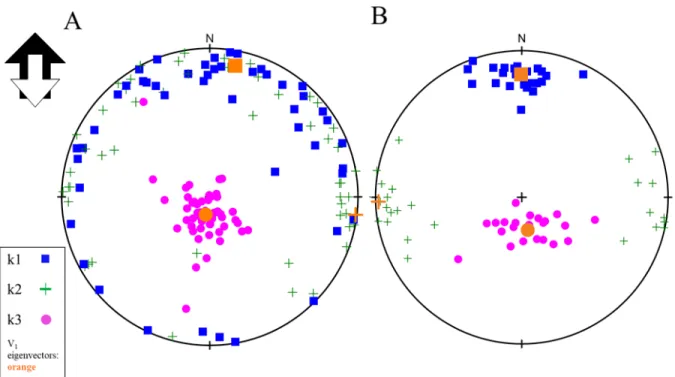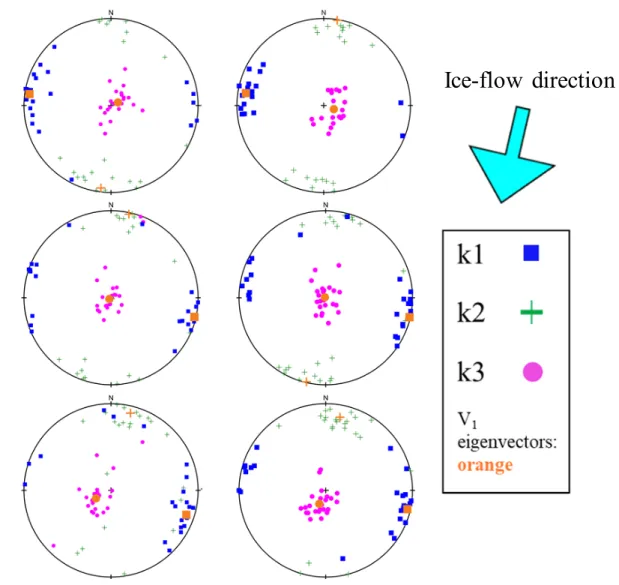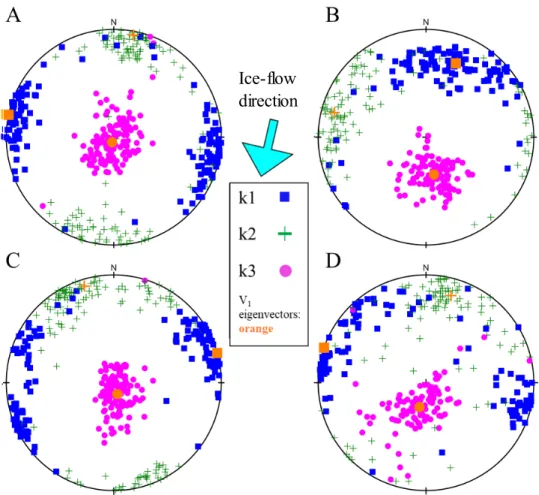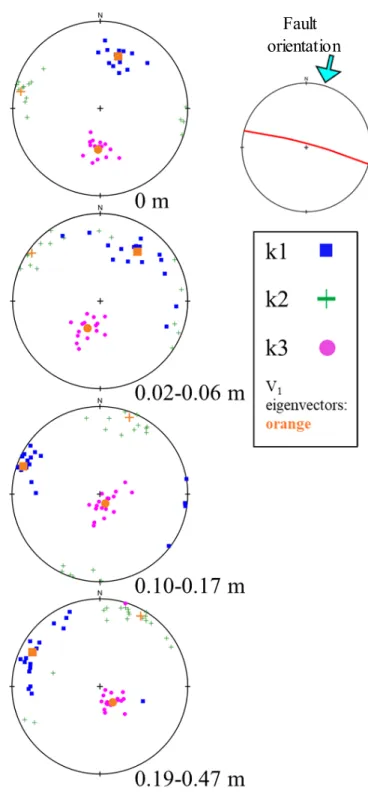HAL Id: hal-03033129
https://hal.archives-ouvertes.fr/hal-03033129
Submitted on 7 Dec 2020HAL is a multi-disciplinary open access archive for the deposit and dissemination of sci-entific research documents, whether they are pub-lished or not. The documents may come from teaching and research institutions in France or abroad, or from public or private research centers.
L’archive ouverte pluridisciplinaire HAL, est destinée au dépôt et à la diffusion de documents scientifiques de niveau recherche, publiés ou non, émanant des établissements d’enseignement et de recherche français ou étrangers, des laboratoires publics ou privés.
and conditions during thrusting
Matthew Warbritton, Neal Iverson, France Lagroix, Anders Schomacker
To cite this version:
Matthew Warbritton, Neal Iverson, France Lagroix, Anders Schomacker. Strain patterns in glacitec-tonically thrusted sediments and conditions during thrusting. Journal of Structural Geology, Elsevier, 2020, 137, pp.104064. �10.1016/j.jsg.2020.104064�. �hal-03033129�
1 1
2
Strain patterns in glacitectonically thrusted sediments and
3
conditions during thrusting
4 5
Matthew.J. WARBRITTONa, Neal R. IVERSONa*, France LAGROIXb, and Anders
6
SCHOMACKERc
7 8
aDepartment of Geological and Atmospheric Sciences, Iowa State University, 2237 Osborn Dr.,
9
Ames, IA 50011, USA
10
bInstitut de Physique du Globe de Paris, Sorbonne Paris Cité, Univ. Paris Diderot, UMR 7154
11
CNRS, 1 rue Jussieu, 75005 Paris, France
12
c Department of Geosciences, UiT—The Arctic University of Norway, Tromsø, Norway
13 14
*Corresponding author: Neal R. Iverson, Department of Geological and Atmospheric
15
Sciences, Iowa State University, 2237 Osborn Dr., Ames, IA 50011, USA
16
email: niverson@iastate.edu
17
t: 1 515 294 8048
18
Keywords: Glacitectonic deformation; Thrust sheets; Anisotropy of magnetic 19
susceptibility; Permafrost; Pore pressure 20
21 22
2
Strain patterns in glacitectonically thrusted sediments and conditions during
23
thrusting
24
Abstract 25
Glacitectonically thrusted blocks of unlithified sediment are commonly inferred to have been 26
frozen during thrusting, with implications for paleoclimate and glacier dynamics. We inferred 27
strain patterns within thrusted blocks of glaciolacustrine mud in the Rubjerg Knude and Møns 28
Klint glacitectonic complexes of coastal Denmark to try to assess whether the mud was frozen 29
during thrusting. Fabrics based on the anisotropy of magnetic susceptibility (AMS) of the muds 30
are interpreted with results of ring-shear experiments and models of AMS fabric development 31
during layer-parallel shortening (LPS). In intact distal stratigraphy, fabrics indicate moderate 32
LPS. Fabrics where thrusts have disrupted more proximal stratigraphy indicate rotation of mud 33
sheets during thrusting with insufficient penetrative strain to reset the LPS fabric. The exception 34
is within decimeters of faults at Rubjerg Knude where shear overprinted the LPS fabric. 35
Although these data indicate that mud sheets were mostly rigid during thrusting, this is not 36
necessarily evidence of permafrost. Critical-taper theory indicates that even a gentle slope of the 37
proglacial surface away from the glacier margin would have allowed slip without internal 38
deformation of thrust sheets, requiring only minimal pore-water pressures. 39
1. Introduction 40
Glacitectonic thrust complexes with along-flow lengths of kilometers and depths of tens to a 41
few hundreds of meters (e.g., Pedersen, 2014; Phillips, 2018) are among the most spectacular of 42
glacial geologic structures. Interest in them derives from their geomorphic expression, 43
commonly as composite ridges that form end moraines or as the hills of hill-hole pairs (e.g., 44
Aber and Ber, 2007). They are also of interest as analogs for orogenic belts (Croot, 1987; 45
3
Hudleston, 1992; Bennett, 2001; Van der Wateren, 2002; Phillips, 2018) and because of the short 46
periods over which they can form (Benediktsson et al., 2010). Environmental effects of thrust 47
complexes include their influence on subsurface water flow (e.g., Klint et al., 2013), on rates of 48
mass wasting and erosion of coastal cliffs (Pedersen and Møller, 2004; Kołodziejczyk et al., 49
2018), and on site selection for future nuclear waste repositories (Talbot, 1999; Iverson and 50
Person, 2012). 51
Importantly, glacitectonic thrust complexes may also provide information about whether 52
climates at the margins of former glaciers were sufficiently cold to sustain permafrost. Thrust 53
complexes form beneath glacier margins and can extend in front of them more than 5 km in 54
exceptional cases (Aber and Ber, 2007). Although complexes sometimes contain thrust blocks 55
consisting of sedimentary rocks, some or all of thrusted material is usually weaker, unlithified, 56
glacigenic sediment. As emphasized in reviews by Bennett (2001) and Van der Wateren (2002), 57
such sediments are commonly inferred to have been frozen during thrusting (e.g., Mathews and 58
Mackay, 1960; Moran et al., 1980; Thomas, 1984; Menzies, 1990; Mooers, 1990; Boulton et al., 59
1999; Benn and Clapperton, 2000; Clayton et al., 2001; Burke et al., 2009). 60
Although proglacial thrusting can definitively occur in the absence of permafrost (e.g., 61
Ingólfsson, 1988; Van der Wateren, 2002; Kuriger et al., 2006; Benediktsson et al., 2009), we 62
explore whether the distribution of strain in individual thrust blocks of complexes can be used to 63
test whether sediments were frozen during thrusting. Specifically, frozen sediments are expected 64
to be stronger (e.g., Moore, 2014) and less subject to ductile strain than unfrozen sediments (e.g., 65
Feeser, 1988), particularly at temperatures well below the freezing point, at which weakening by 66
pre-melted water is minimal (Moore, 2014; Wang and Nishimura, 2017). 67
4
Herein we investigate strain patterns within the fine-grained sediments of selected thrust 68
sheets of two glacitectonic complexes of coastal Denmark: Rubjerg Knude and Møns Klint (e.g., 69
Johnstrup, 1874, 1882; Jessen, 1899; Pedersen, 2014). Strain patterns are determined by 70
measuring the anisotropy of magnetic susceptibility (AMS) of the sediments. Determination of 71
the magnetic mineralogy, results of ring-shear experiments in which sediments were sheared, and 72
models of AMS fabric development in orogenic fold and thrust belts are used to interpret the 73
AMS data. We find that thrust blocks behaved too rigidly to reset fabrics during thrusting, except 74
within decimeters of bounding thrust surfaces. Considering shear stresses on thrust faults 75
indicates, however, that a combination of positive pore-water pressure and a proglacial surface 76
sloping down-flow above thrusts can cause thrusting of rigid slabs without added shearing 77
resistance provided by pore ice. 78
2. Field settings 79
The Rubjerg Knude and Møns Klint glacitectonic complexes of Denmark consist of 80
décollement surfaces that dip gently up-glacier, as inferred from reconstructions based on 81
exposed stratigraphy and structures and isostatic depression by ice (Pederson, 2005; Pedersen 82
and Gravesen, 2009). The décollements are overlain by thrust faults consisting of ramps and 83
flats and associated anticlines and synclines. Both complexes formed in front of the advancing 84
margin of the Scandinavian Ice Sheet (e.g., Houmark-Nielsen & Kjær, 2003; Pedersen, 2014) 85
and are structurally similar to thrusted and folded orogenic belts. These complexes lie in the 86
region that Sollid and Sorbel (1988) thought was a sub-freezing marginal zone of the ice sheet, 87
based on relict ice-cored moraines and ice-wedge polygons. 88
89
90
5
2.1. Rubjerg Knude
91
The Rubjerg Knude complex, first recognized by Johnstrup (1874, 1882) and studied in 92
detail by Pedersen (2005), is located in northwestern Denmark along the northwest coast of 93
Jutland (Fig. 1). The complex is well exposed for 6 km along a coastal cliff that is 60 m above 94
sea level at its highest point. The complex consists entirely of Weichselian or younger deposits, 95
including marine mud, glaciolacustrine mud, glaciofluvial sand and gravel, and till. 96
Of interest here, with decreasing age, are the Stortorn Formation (SF), Lønstrup Klint 97
Formation (LKF), and Rubjerg Knude Formation (RKF). The SF consists of predominantly clay 98
of the Older Yoldia Sea of the Middle Weichselian (Jensen, 1993). The sea existed until about 32 99
ka BP (Seidenkrantz and Knudsen, 1993) when the outlet to the North Sea was blocked by the 100
Norwegian Channel Ice Stream. This created an ice-dammed lake that persisted from ~32 to 29 101
ka BP (Sadolin et al., 1997; Houmark-Nielsen, 1999) and deposited the glaciolacustrine mud that 102
dominates the LKF. Close to 29 ka BP, the lake drained catastrophically, resulting in an 103
unconformity between the LKF and overlying glaciofluvial sand and gravel of the RKF (Sadolin 104
et al., 1997). At ~29 ka BP, during deposition of the RKF, the Kattegat Ice Stream (Houmark-105
Nielsen, 2008), advanced south-southeast across the northern tip of Jutland (Fig. 1), initiating 106
deformation at Rubjerg Knude along a décollement ~40 m below sea level in the marine clay of 107
the SF (Pedersen, 2005). Faulting and folding extended 12 km in front of the glacier margin and 108
resulted in average shortening of 50%; thrust faults generally dip more steeply in the northern 109
and central areas where the décollement is deepest (Fig. 2A) (Pedersen, 2005). 110
In this study we focus on a distal section of the complex, called Ulstrup (Pedersen, 2005), 111
and a central section called Grønne Rende, with steeply dipping thrust sheets (Fig 2). The 112
Ulstrup section consists of predominantly horizontal layers of the LKF overlying the RKF. The 113
6
section was considered to be undeformed until Pedersen (2005) found evidence for a horizontal 114
décollement at the southern end of the section along which the flat-lying sediment layers have 115
been displaced ~500 m. Otherwise the stratigraphy in this distal part of the complex is mostly 116
intact. In contrast, the Grønne Rende section consists of 13 steeply-dipping, and in some cases 117
near-vertical, thrust sheets. The LKF forms the most conspicuous sheets (Fig. 3), owing to the 118
ability of its mud to support vertical exposures. The sand and gravel of the RKF is interpreted to 119
have been syntectonically deposited in between and on top of thrust sheets during progressive 120
faulting and sheet rotation during longitudinal shortening (Pedersen, 2005). The average 121
displacement along these faults is 70 m (Pedersen, 2005). 122
Small-scale structures may provide insight into the formation of the complex. Ball-and-123
pillow structures within the LKF may indicate where rapid loading caused pore-water pressure to 124
increase, leading to local diapir-like deformation of bedding surfaces (Lowe, 1975). Frost 125
wedges observed by Pedersen (2005) in the RKF near the paleo-ground surface indicate that 126
some frozen sediments were present during deformation. Also present in the RKF and perhaps 127
indicative of frozen sediments are kilelags (Pedersen, 2005), fissures that have opened during 128
initial brittle deformation and are filled with water-transported, syntectonically-deposited sand 129
(Sjørring, 1977). 130
2.2. Møns Klint
131
Møns Klint, in southeastern Denmark at Høje Møn (Fig. 1), has been a foundational location 132
for study of glacitectonics (e.g., Puggaard, 1851; Aber, 1980, 1982; Aber and Ber, 2007). The 133
exposure, in coastal cliffs that reach heights of 130 m and span 4 km, consists of Upper 134
Cretaceous chalk thrusted over Weichselian sediments (Fig. 4). The sedimentary succession 135
includes the Ristinge Klint Till deposited ~60 ka BP by the Baltic ice advance from the 136
7
southeast, glaciolacustrine mud deposited after the recession of the Baltic ice, and till deposited 137
25-18 ka BP by ice advances from the northeast and glaciofluvial sand (Houmark-Nielsen, 1987; 138
Pedersen and Gravesen, 2009). 139
The initial deformation at Møns Klint commenced during the advance of the Young Baltic 140
Ice Stream from the south-southeast at ~18 ka BP (Houmark-Nielson and Kjær, 2003). 141
Deformation occurred along a décollement 80-100 m below sea level (Pedersen and Gravesen, 142
2009) and extended approximately 9 km in front of the advancing glacier. A later ice advance 143
from the northeast out of Sweden (16-17 ka) (Houmark-Nielsen, 2007) superimposed 144
deformation onto the eastern edge of the northern part of the complex from Slotsgavlene to 145
Maglevandsfald (Fig. 4) ( Pedersen and Gravesen, 2009). The southernmost expression of the 146
superimposed deformation is near Maglevandsfald where a till wedge within chalk is folded 147
along an axis trending NW-SE (Pedersen and Gravesen, 2009). Farther south in the proximal part 148
of the complex (Pedersen, 2000), there is no evidence of the advance from the northeast, with 149
thrust faults striking approximately perpendicular to the Baltic Ice Stream advance from the 150
south-southeast (Fig. 4). 151
3. Methods 152
We use AMS, as a proxy for particle alignment, to interpret strain patterns in thrusted blocks. 153
This method has been applied to tills deformed subglacially, using ring-shear experiments to 154
calibrate AMS to strain magnitude and direction (Thomason and Iverson, 2009; Shumway and 155
Iverson, 2009, Vreeland et al., 2015, McCracken et al., 2016; Ives and Iverson, 2019), and 156
applied to glacier ice with debris (Fleming et al., 2013a) and to sediments with glaciotectonic 157
structures (Fleming et al., 2013b). Using AMS in glacial sediments requires collecting multiple, 158
closely-spaced, intact sediment specimens, so a fabric representative of the sampled region can 159
8
be determined. Tests to determine magnetic mineralogy of the sediments (Appendix) and a ring-160
shear experiment on mud from Rubjerg Knude also contribute to our interpretations. 161
162
3.1. AMS Sampling
163
To collect samples a planar face is created by scrapping an exposure sufficiently to expose 164
undisturbed sediment. Aluminum, 18 mm, cubic boxes, open on two ends, are inserted in the 165
face in as tight a grid as was possible without disturbing adjacent boxes (Fig. 5), with 18-25 166
samples used to determine a fabric. Plastic boxes usually used for such sampling (e.g., 167
McCracken et al., 2016) are too weak to be pressed into the hard, consolidated muds of 168
glacitectonic complexes. After measuring the orientation and position of each box, it is 169
excavated, with excess mud trimmed from the open ends of the box with a wire saw. With a 170
plunger the mud is extruded into a plastic box of the same size and the box capped, labelled, and 171
sealed in plastic to inhibit moisture loss. In a few cases sandier layers can be sampled by pushing 172
plastic boxes into the sediment directly. 173
At Rubjerg Knude, sampling was focused on thrust sheets in the Grønne Rende section (Fig. 174
2B), but additional samples were collected within the mostly intact stratigraphy of the distal 175
Ulstrup section (Fig. 2C). The distal end of the complex was chosen for sampling to determine 176
strain patterns in the absence of pervasive thrusting, so the effects of thrusting on strain in the 177
Grønne Rende section could be isolated. Samples at both sections were mainly from the 178
glaciolacustrine mud of the LKF because its cohesion allowed the collection of minimally 179
disturbed samples, unlike the friable sand of the RKF. At Ulstrup, flat-lying mud (striking 273°, 180
dipping 3° south) of the LKF (Fig. 2B) was sampled along two vertical transects (three fabrics 181
per transect), beneath the unconformity with the RKF. 182
9
At Grønne Rende the primary objective was to sample thrust blocks along transects normal to 183
fault surfaces. Three thrust sheets (GR10, GR07, and GR05, Fig. 2a) with conspicuous, near-184
vertical exposures of the LKF were chosen for study based largely on their accessibility and 185
safety concerns. These sheets have strikes of 266-285° in agreement with thrusting driven by the 186
Kattegat Ice Stream advancing from the north and dips of 56° N to near vertical. Also accessible 187
at GR10 and GR07 were dip-slopes of the LKF eroded into the cliff-face by mass wasting 188
processes along bedding planes, so these surfaces were also sampled, taking care in all cases to 189
measure the orientation of samples. 190
Our principal concern is how strain varied with distance from the surfaces of thrust faults, so 191
through-going fault surfaces needed to be identified. At Rubjerg Knude we used slickensides that 192
result from P shears and Riedel shears that grow and intersect during slip, forming asymmetric 193
steps on fault surfaces (Petit, 1987; Doblas, 1998) near the base of the LKF (Fig. 6). In thrust 194
sheets GR10 and GR05, slickensides could at some locations be identified and were used to 195
reference fault-normal transects of AMS samples (Fig. 7A, B). No slickensides were found at 196
thrust sheet GR07. Although some samples for AMS fabrics were gathered in thrust sheets in the 197
absence of adjacent slickensides (Warbritton, 2019), we report data from fault-normal transects 198
only where slickensides provided an indicator of thrust position (13 fabrics). We also consider 199
AMS fabrics collected from two eroded dip-slopes (6 fabrics) distant from thrust faults. 200
At Møns Klint, glaciolacustrine mud of the Middle Weichselian in the proximal part of the 201
complex (Fig. 4), overlain along a sharp, gently dipping contact by Maastrichtian chalk (Fig. 5), 202
was sampled along a 4 m long section (Fig. 8). The fault between the chalk and mud strikes 79° 203
(±7°) and dips 18° (±4°), consistent with thrusting driven by the Young Baltic ice stream 204
advance from south-southeast (Pederson and Gravesen, 2009). Samples were gathered in four 205
10
adjacent vertical transects, 0.9-2.0 m high, referenced to the contact and sufficient for 17 AMS 206
fabrics. 207
3.2. AMS analysis
208
AMS was measured with a KLY-3S Kappabridge at the University of Wisconsin-Madison. 209
This device subjects a sample to a magnetic field of constant strength, H, in 15 different 210
orientations. The intensity of magnetization, M, is defined as kH, where k is the susceptibility 211
(Jelínek, 1978; Tarling and Hrouda, 1993). In three dimensions, the susceptibility is described 212
with a second-rank tensor, and the principal susceptibilities of this tensor, k1, k2, and k3, are
213
represented as the long, intermediate, and short axes, respectively, of an ellipsoid. In materials
214
that are anisotropic, the susceptibility varies with sample orientation. For non-equant magnetic 215
grains that are multi-domain or pseudo-single-domain and have shape anisotropy, such as 216
magnetite, the susceptibility is strongest parallel to the long axes of grains (Tarling and Hrouda, 217
1993). Deformation of sediment preferentially aligns grains and creates AMS. As described in 218
the Appendix, mineral magnetic analyses were conducted at the Institut de Physique du Globe de 219
Paris to determine the mineralogy and magnetic grain size of the dominant AMS carrier of the
220
muds from the two complexes. 221
If the orientations of principal susceptibilities are measured for each of multiple till samples, 222
they together define a fabric that helps indicate the magnitude and orientation of strain (Hooyer 223
et al., 2008). The orientations of maximum clustering of k1, k2, and k3 are each characterized with
224
a V1 eigenvector, and the strength of the preferred orientation about V1 is characterized with an S1
225
eigenvalue (Mark, 1973). We thus analyze orientations of principal susceptibilities separately, 226
rather than using tensor statistics. For poorly clustered data, our technique can lead to V1
227
eigenvectors for k1, k2, and k3 orientations that are not orthogonal. However, principal
11
susceptibility orientations from our field samples are well-clustered, so we elect to follow the 229
tradition in glacial geology of using eigenvectors and eigenvalues to characterize fabrics. S1 = 1.0
230
indicates perfect alignment and S1 = 0.33 indicates an isotropic distribution (i.e., no alignment).
231
Orientation data are plotted in lower hemisphere, equal-area stereonets. Importantly, in 232
stereonets displaying fabrics from dipping thrust sheets, the plane of the primitive circle is taken 233
to be the attitude of the thrust sheet, as indicated by the orientations of thrust faults adjacent to 234
sampling locations or as indicated by bedding attitude in the case of samples from dip-slopes. 235
This allows easier comparison with experimental and field data in which shear or bedding is 236
horizontal. At sections studied where both fault and bedding attitudes could be measured, they 237
tended to be nearly the same (< 3⸰ differences in strike and dip), although elsewhere at Rubjerg
238
Knude that is not necessarily true (Pederson, 2005). In the massive mud sampled at Møns Klint, 239
no bedding could be identified. 240
3.3. Ring-shear experiment
241
To help establish the relationship between shear strain orientation and the AMS signature, an 242
experiment with a ring-shear device was conducted with mud of the LKF. The device (Iverson et 243
al., 1997) has been used extensively to shear subglacial till with the same objective (Hooyer et 244
al., 2008; Shumway and Iverson, 2009; Vreeland et al., 2015; McCracken et al., 2016; Ives and 245
Iverson, 2019). Sediment with its pore water drained to atmospheric pressure is sheared within a 246
ring-shaped chamber (O.D.= 0.6 m, width = 0.115 m) between horizontal platens. The upper 247
platen, which can move up or down as sediment porosity changes, applies a steady stress normal 248
to the shear plane. During shear, the lower platen and lateral walls of the lower half of the sample 249
chamber rotate at a constant speed. Shearing occurs in a zone, < 35 mm thick, centered on the 250
break between the rotating lower walls and static upper walls. 251
12
The LKF mud was first vigorously mixed with distilled water so aggregates would break 252
down and grain orientations would be randomized. The mixture was then added to the sample 253
chamber as a slurry to a thickness of 0.06 m. A normal stress (65 kPa) was applied for a period 254
of 11 days to consolidate the mud. The amount of consolidation (14.5%) was determined by 255
using two dial gauges to measure the downward movement of the upper platen, which resulted 256
from the decrease in specimen thickness. The test was then run at a constant shear rate of 1.27 × 257
10-5 m/s to a displacement of 0.6 m along the sample centerline. After the test was completed, 53
258
samples were collected for AMS analysis. A smooth, flat surface was exposed just below the 259
uppermost extent of the shear zone, as inferred from past experiments on tills (Hooyer et al., 260
2008), and samples were collected by pressing into the mud plastic boxes like those used for the 261 field measurements. 262 4. Results 263 4.1. Experiments 264
Tests aimed at assessing magnetic mineralogy indicate that the dominant carrier of magnetic 265
susceptibility of the glaciolacustrine muds from the two thrust complexes is multi-domain or 266
pseudo-single domain magnetite (Appendix). Such magnetite has normal shape anisotropy 267
(Tarling and Hrouda, 1993), so the orientations of principal susceptibilities should reflect grain 268
orientation. 269
This expectation is confirmed at Rubjerg Knude by the ring-shear experiment conducted on 270
the mud sampled there (Fig. 9A). The V1 orientation based on 53 k1 orientations indeed parallels
271
the shearing direction and plunges “up-glacier” 11°, consistent with past ring-shear experiments 272
on AMS of tills with magnetite as the dominant carrier mineral, including tills derived from 273
remobilized lake sediments (Fig. 9B) (Hooyer et al., 2008; Thomason & Iverson, 2009; Vreeland 274
13
et al., 2015; Ives and Iverson, 2019). Also consistent with past experiments are the orientations 275
of V1 for k2 and k3: k2 orientations are horizontal and perpendicular to shear, and k3 orientations
276
plunge steeply (~80°) “down-glacier.” However, unlike past results of experiments on tills, 277
including on those consisting of remobilized lake sediments (Fig. 9B), clustering of k1 and k2
278
orientations is weak, with S1= 0.59 in each case as opposed to S1 > 0.9 for fine-grained till
279
(Hooyer et al., 2008). Rather than clustering strongly, these principal susceptibilities form 280
asymmetric girdles that dip gently “up-glacier” (Fig. 9A). 281
Unlike many studies of the magnetism of deformed rocks, we do not use various indices of 282
the magnitude of anisotropy of individual samples to infer strain; ring-shear experiments 283
conducted to wide a range of strains on tills that contain magnetite as the source of AMS show 284
no systematic dependence of these indices on strain magnitude (Hooyer and Iverson, 2008; 285
Vreeland et al., 2015). 286
4.2. Rubjerg Knude
287
Principal-susceptibility orientations for the six fabrics from the distal end of the Rubjerg 288
Knude thrust complex (Ulstrup section) display a relatively uniform pattern (Fig. 10). Here, the 289
mud and overlying sand units are horizontal and with little macroscopic evidence of deformation. 290
A stereonet combining principal-susceptibility orientations from these fabrics (Fig. 11A) 291
demonstrates strong clustering of the three principal susceptibilities (S1 ≥ 0.81). Orientations of
292
k1 cluster near perpendicular to the glacier flow direction (south-southwest, Pedersen, 2005), k2
293
orientations are close to horizontal and parallel to the flow direction, and k3 orientations plunge
294
near vertically. 295
In thrust sheets of the Grønne Rende section, four fabric transects, one in GR10 and three in 296
GR05, were measured normal to bounding thrust faults with well-exposed fault slickensides (Fig. 297
14
12, 13). In all cases, orientations of principal susceptibilities are clustered (S1 ≥ 0.77). However,
298
two distinct fabric patterns are evident depending upon distance from the fault. Within 0.1 m and 299
~0.7 m of the GR10 and GR05 fault surfaces, respectively, orientations of principal 300
susceptibilities are similar to those of ring-shear experiments (Fig. 9), if data are plotted relative 301
to the attitude of the fault surfaces. If all data from close to faults are combined in a single such 302
stereoplot, the similarity is clearest (Fig. 11B, compare with Fig. 9A, B): the V1 of k1 orientations
303
is roughly parallel to the glacier flow direction (SSW) and plunges gently up-glacier relative to 304
the plane of the fault. Orientations of k2 cluster perpendicular to the shear direction. Orientations
305
of k3 are clustered the strongest (S1 = 0.92) and steeply plunge down-glacier relative to the plane
306
of the fault. A difference between the field and ring-shear AMS data is that k2 and k3 clusters are
307
rotated ~10º around the axis of the k1 cluster
308
In contrast, farther away from faults, orientations of principal susceptibilities cluster similarly 309
to fabrics from the distal part of the thrust complex at Ulstrup (Fig. 11C, compare with Fig. 310
11A): k1 orientations cluster in the fault plane and sub-perpendicular to the flow direction; k2
311
orientations also cluster in the fault plane but sub-parallel to the flow direction. Orientations of k3
312
cluster normal to the fault surface. Unlike fabrics from Ulstrup, k1 and k2 clusters are rotated
313
counterclockwise 27° from being perpendicular and parallel to the regional glacier flow 314
direction, respectively. Possibly significant, however, is that five of the seven fabrics used to 315
compile Figure 11C are from thrust sheet GR05, which strikes in a direction consistent with a 316
local thrusting direction that is similarly rotated (Fig. 13). 317
All fabrics from samples collected from eroded dip-slope surfaces away from faults and 318
plotted on stereonets relative to the dip of the bedding also have AMS fabrics similar to those at 319
the distal end of the thrust complex. Combining the susceptibility orientations from these fabrics 320
15
on one stereonet shows this clearly (Fig. 11D, compare with Fig. 11A). Orientations of k1 cluster
321
near perpendicular to the glacier flow direction; k2 orientations cluster in the plane of the bedding
322
and parallel to the flow direction, and k3 orientations cluster parallel to the glacier flow direction
323
and plunge near-normal to bedding. A slight difference is that k2 and k3 clusters from dip-slope
324
fabrics indicate they dip up-glacier relative to bedding, approximately 15°. 325
4.3. Møns Klint
326
Fabrics from the exposure at Møns Klint, if plotted on stereonets relative to the plane of the 327
fault and grouped according to their distance from it (Fig. 14), are similar to some fabrics at 328
Rubjerg Knude. Orientations of k1 cluster either roughly perpendicular to the glacier-flow
329
direction (NNW, as inferred by Pedersen and Gravesen (2009) from the strikes of thrust faults in 330
the complex) or at an angle less than ~45° to the flow direction. Orientations of k3 tend to cluster
331
with steep plunges up-glacier; k2 orientations are the most weakly clustered but tend either to
332
plunge slightly down-glacier, where k1 clusters are perpendicular to flow (Fig. 14, < 0.36 m,
333
1.19-1.8 m), or to trend at an angle greater than ~50° to the flow direction where k1 clusters are
334
more closely aligned with the flow direction (Fig. 14, 0.51-0.98 m). The former fabrics are 335
similar to those of the intact distal stratigraphy of the Rubjerg Knude complex (Fig. 11A), as 336
well as parts of thrust sheets in that complex away from faults (Fig. 11C, D). 337
5. Discussion 338
5.1. AMS fabric interpretation
339
In addition to our results indicating that the AMS of the thrust sheets is controlled by multi-340
domain or pseudo-single domain magnetite (Appendix), we have two means of interpreting AMS 341
fabrics. Results from ring-shear experiments on the LKF mud and on tills provide a model for 342
AMS development in till deformed predominately in simple shear. In addition, models of AMS 343
16
fabric development in larger-scale compressional tectonic environments, tested experimentally, 344
provide guidance for interpreting fabric development during layer-parallel shortening. 345
Experimental shearing of the LKF mud yields V1 eigenvectors for the three principal
346
susceptibilities that are similar to those obtained in identical experiments conducted on fine-347
grained tills in which magnetite was the dominant magnetic mineral (Fig. 9). Eigenvectors based 348
on k1 orientations are close to the shearing direction (within 11º) and plunge gently up-glacier;
349
those based on k2 orientations are nearly perpendicular to the shearing direction (within 7º) in the
350
plane of the fault, and those based on k3 plunge steeply down-glacier.
351
Dissimilar, however, is that in the experiment on mud, k1 and k2 orientations did not cluster
352
but formed asymmetric girdles (Fig. 9A), despite shearing displacements that were just as large 353
as in the till experiments. The lack of clustering of k1 and k2 orientations likely reflects strain
354
localization in the mud in thin shear bands, a characteristic behavior of clay-rich soils in 355
geotechnical experiments in which strain commonly localizes in zones 0.3-10 mm thick 356
(Morgenstern and Tchalenko, 1967; Hicher et al., 1994). AMS samples, in contrast, were 357
collected after the experiment over a mud thickness of 16 mm (the sampling box dimension), 358
which would have resulted in the collection of significant volumes of unsheared mud. This 359
unsheared mud, owing to its consolidation prior to the experiment and associated rotation of 360
particles toward the horizontal, would have had a k1–k2 girdle in the plane of shear and a vertical
361
cluster of k3 orientations (e.g., Tarling and Hrouda, 1993; Parés, 2015). The asymmetric k1–k2
362
girdle that is observed, therefore, likely reflects a significant volume of unsheared mud in the 363
AMS samples. Thus, although eigenvectors from the mud experiment are fully consistent with 364
those developed from simple shear of tills, clustering of k1 and k2 orientations from experiments
365
with fine-grained till probably better reflects the AMS response of the mud to simple shear, as 366
17
long as thicknesses of shear zones sampled in the field exceeded the thickness of sample boxes. 367
We conclude, therefore, that the clustered orientations of principal susceptibilities obtained in 368
ring-shear experiments on tills, formed subglacially through remobilization of glaciolacustrine 369
mud and with their AMS controlled by magnetite (Fig. 9b), is an appropriate model for the muds 370
of this study, if they have been subjected to a sufficient strain. 371
On that basis, a solid conclusion is that the fabric pattern close to thrust faults (< ~0.7 m) at 372
Rubjerg Knude (Fig. 11b) reflects shear of the mud during thrusting. Shear must have been to a 373
sufficiently high strain close to faults to fully overprint the AMS fabric that existed prior to 374
thrusting. At Møns Klint, on the other hand, despite collection of AMS samples as close as 3 cm 375
to the fault between the chalk and underlying mud, this fabric pattern indicative of simple shear 376
is absent. 377
Additional insights into the fabric patterns at Rubjerg Knude and Møns Klint come from 378
studies of AMS fabric development in deformed rocks (see Borrradaile and Henry, 1997; Parés, 379
2015, for reviews) and sediments (e.g., Collombat et al., 1995; Housen and Kanamatsu 2003; 380
Caricchi et al, 2016) in crustal tectonic environments. A leading model developed from such 381
field studies (notably by Averbuch et al., 1992; Borradaile and Henry, 1997; Bakhtari et al., 382
1998; Saint-Bezar et al., 2002) and more recently tested in analogue sandbox experiments 383
(Almqvist and Koyi, 2018) allows interpretation of fabrics resulting from layer-parallel 384
shortening (LPS) in fold and thrust belts and accretionary prisms. The model (Fig. 15) describes 385
the change in AMS fabric pattern from a depositional fabric, found in forefield regions, to fabrics 386
indicative of progressively higher-strain LPS towards the hinterland. The depositional fabric, 387
with k3 orientations clustering vertically and k1 and k2 orientations in a horizontal girdle (fabric 1
388
of Fig. 15), reflects the horizontal settling and subsequent consolidation during burial of oblate, 389
18
clay-sized particles (Tarling and Hrouda, 1993). Common in fold-thrust environments are 390
intermediate fabrics in which this depositional fabric has been overprinted by a small amount of 391
LPS. This fabric (fabric 2 of Fig. 15) reflects consolidation greater than LPS, such that k3
392
orientations remain vertical. Orientations of k1, however, rotate into the direction of maximum
393
extension, which is horizontal and perpendicular to the shortening direction. With still more LPS, 394
a vertical k2-k3 girdle forms parallel to shortening (fabric 3), which transitions at still greater
395
strain to k2 and k3 clusters that are vertical and parallel to the shortening direction, respectively
396
(fabric 4). This highest-strain AMS fabric has been measured in till interpreted to have been 397
extruded upward into basal crevasses (Ankerstjerne et al., 2015). 398
AMS fabrics measured at Rubjerg Knude in the distal Ulstrup section and away from thrusts 399
in the Grønne Rende section, as well as most fabrics measured at Møns Klint, are similar to 400
fabric 2 of this model. Orientations of k1 cluster in the plane of the bedding or fault and
401
perpendicular or sub-perpendicular to the thrusting direction; k2 orientations also cluster in the
402
plane of the fault or bedding but are parallel or sub-parallel to thrusting, and k3 orientations either
403
cluster vertically or are steeply dipping. Therefore, prior to thrusting of mud sheets at Rubjerg 404
Knude and Møns Klint the mud was consolidated (fabric 1, Fig. 15) and underwent minor 405
shortening parallel to bedding. More importantly, thrusting did not change this fabric at Grønne 406
Rende, except within decimeters of fault surfaces where simple shear reset the LPS fabrics. At 407
Møns Klint, there is no evidence of thrusting resetting this fabric, likely indicating that shear was 408
focused in the ~3 cm of mud closest to the fault where the mud was not sampled (Figs. 5 and 14). 409
AMS of sediments across basal décollements of accretionary prisms sometimes indicate a similar 410
lack of detectable overprinting by shear deformation (Housen et al., 1996). In contrast, the 411
superimposed deformation onto the eastern edge of the northern part of the complex from 412
19
Slotsgavlene to Maglevandsfald (Fig. 4), which occurred later, recumbently folded the glacial 413
sediments (Pedersen and Gravesen, 2009), likely resetting LPS fabrics. 414
The clear implication is that during thrusting sheets were rotated, with little internal 415
deformation except very near faults. As noted, a leading hypothesis for glacitectonic thrusting of 416
rigid sheets of unlithified sediment is that permafrost made thrusting of coherent sheets possible 417
through some combination of increasing their strengths and serving as a barrier for groundwater 418
flow. In that case, the narrow zones of shear near thrust surfaces might be interpreted as the 419
result of heat dissipation during slip and the associated warming or melting of pore ice there. 420
Warbritton (2019) showed that heat dissipation from the average displacement on faults at 421
Rubjerg Knude estimated by Pedersen (2005, ~70 m) was sufficient to warm permafrost 422
substantially near slip surfaces. Potentially this softened the permafrost through production of 423
pre-melted water, enabled strain localized in narrow zones, and reduced shear stresses 424
sufficiently to allow the slip of mostly intact sheets. 425
5.2. Thrusting of intact sheets without permafrost
426
We now step back and consider more generally whether thrusting of largely intact sediment 427
sheets can occur under fully thawed conditions, by appealing to the effects of pore-water 428
pressure and thrust geometry rather than to permafrost. Consider a thrust sheet (Fig. 16) with the 429
wedge geometry commonly considered in studies of crustal faulting (e.g., Turcotte and Schubert, 430
2014). Wedge-shaped thrust sheets were also considered by Pedersen (2005) in his 431
reconstructions of thrusting at Rubjerg Knude. The upper surface of the thrusted wedge slopes at 432
an angle, α, toward the distal end of the wedge, as expected if layer-parallel shortening is largest 433
near the glacier margin and is accompanied perhaps by proximal thrusting in the wedge. The 434
thrust ramp dips in the opposite direction at an angle, β. The thickness of the wedge, H, is 435
20
defined normal to the thrust surface. The wedge is pushed from upstream along the x coordinate, 436
defined parallel to the thrust ramp, by a force that reflects the depth integral of the stress, σx (Fig.
437
16). In the opposite direction is a shear stress, τb, acting along the base of the thrust ramp.
438
In their study of the mechanics of fold and thrust belts, Davis et al. (1983) balanced forces on 439
the wedge and considered the stresses required for its Coulomb failure to estimate τb for the
440
special case of a wedge deforming internally at its Coulomb strength. In that case, shear failure 441
occurs under a traction, S = S0 + µ (σz - pw), where S0 is the sediment cohesion, σz is the total
442
stress, pw is the pore-water pressure, and µ is an internal friction coefficient commonly expressed
443
in terms of a friction angle 𝜑𝜑 such that µ = tan 𝜑𝜑. For the small values of α and β relevant to 444
this problem, for which sin α ≈ α and sin β ≈ β, and assuming the wedge is saturated with water 445
everywhere, Davis et al. (1983) derived the shear stress on the thrust fault required to deform the 446
wedge: 447
𝜏𝜏𝑏𝑏= (𝜌𝜌 − 𝜌𝜌𝑤𝑤)𝑔𝑔𝑔𝑔𝑔𝑔 + (1 − 𝜆𝜆)𝐾𝐾𝜌𝜌𝑔𝑔𝑔𝑔(𝑔𝑔 + 𝛽𝛽), (1)
448
where ρ is the density of the sediment grains of the wedge, and ρw is the density of pore water.
449
Two dimensionless quantities are particularly important in Eq. (1): the water pressure ratio, 450
λ=pw/σz and the parameter, K, which scales with the frictional strength of the wedge. The shear
451
stress at the base must balance the down-slope component of gravity acting on the sloping 452
surface of the wedge, as given by the first right-hand term, and must also balance the force on the 453
upstream end of the wedge as limited by the wedge’s Coulomb strength and given by the second 454
right-hand term. In deriving Eq. (1), Davis et al. (1983) assumed zero cohesion in the wedge, so 455
for the fine-grained and likely cohesive muds of this study, Eq. (1) provides a minimum value of 456
the stress required to deform the wedge. 457
21
For the wedge to slip along its basal fault without deforming the wedge internally, the 458
frictional stress resisting slip, Sb, at the base of the wedge must be less than τb. Defining µb and
459
λb as the friction coefficient and water pressure ratio, respectively, at the base of the wedge,
460
𝑆𝑆b= 𝜇𝜇b(1 − 𝜆𝜆b)𝜌𝜌𝑔𝑔𝑔𝑔. (2)
461
Thus, the condition for slip without internal deformation of the wedge is 462
𝜇𝜇b(1 − 𝜆𝜆b)𝜌𝜌𝑔𝑔𝑔𝑔 < (𝜌𝜌 − 𝜌𝜌w)𝑔𝑔𝑔𝑔𝑔𝑔 + (1 − 𝜆𝜆)𝐾𝐾𝜌𝜌𝑔𝑔𝑔𝑔(𝑔𝑔 + 𝛽𝛽). (3)
463
To maximize slip resistance on the fault and to thereby optimize the potential for deforming a 464
wedge of a given geometry and strength, we assume that λb =λ, despite the possibility that
pore-465
water pressure might be elevated along the fault relative to the wedge overall. Assuming λb =λ,
466
and rearranging Eq. (3) yields the pore-pressure condition required for slip without internal 467
deformation of the wedge: 468
𝜆𝜆 > 1 − 𝛼𝛼�1−𝜌𝜌𝑤𝑤𝜌𝜌�
𝜇𝜇b−𝐾𝐾(𝛼𝛼+𝛽𝛽) . (4)
469
Despite the possibility that sliding friction was less than internal friction, we set the friction 470
coefficient of the fault equal to the internal friction coefficient of the wedge, µb = µ = tan 𝜑𝜑, to
471
further optimize the potential for deforming it. In that case, as shown by Davis et al. (1983), a 472
good approximation for the Coulomb strength factor is 473
𝐾𝐾 = 1−sin 𝜑𝜑sin 𝜑𝜑 +cossin22𝜑𝜑𝜑𝜑. (5)
474
Eqs. (4) and (5) illustrate that if the glacier forefield sloped down-glacier at even a small 475
angle α, a wide a range of pore-pressure ratios could have resulted in thrusting without internal 476
deformation of the thrust sheet. Fields of λ and α above and to the right of the plots of Figure 17 477
indicate thrusting without internal deformation. For the thrust-ramp inclination that characterized 478
initial thrusting in the Grønne Rende section at Rubjerg Knude (18º, Pedersen, 2005, p. 118), 479
22
even hydrostatic pore-water pressure (i.e., no upward groundwater flow) could have resulted in 480
fault slip without internal deformation, as long as α > 4.3º. Still smaller surface slopes would 481
have been required for later stages of faulting at Grønne Rende when thrust ramps became 482
steeper than 30º (Pedersen, 2005). Also, given that upward groundwater flow is common in 483
glacier forefields (e.g., Boulton and Caban, 1995), pore pressures could have easily exceeded 484
hydrostatic. Assumptions made in the derivation of Eqs. (4) and (5) (i.e., no internal cohesion, λb
485
=λ, and µb = µ = tan 𝜑𝜑 also make the estimates of λ and α in Figure 17 required for thrusting
486
without internal deformation conservatively large. 487
Unfortunately values of α are poorly known during thrusting at Grønne Rende. Pedersen’s 488
(2005, p. 159) reconstruction indicates α > 5º late during thrusting, but he argued that at the 489
beginning of thrusting the hinterland of the complex sloped toward the glacier 2º, owing to 490
isostatic depression by the glacier. Uncertainty in the value of α and its evolution during 491
thrusting clearly limit mechanical interpretations. 492
Nevertheless, at Rubjerg Knude and Møns Klint, during phases of thrusting when the 493
proglacial surface sloped away from the glacier, positive pore-water pressure could have caused 494
thrusting of intact sheets of mud in the absence of proglacial permafrost. This interpretation is 495
consistent with the field observations of Pedersen (2005), who interpreted sand-filled cracks, 496
local brecciation, and small-scale mud diapirism at Rubjerg Knude as reflecting high pore-water 497
pressures. It is also consistent with real-time observations of proglacial thrusting of smaller 498
sheets of unfrozen sediments by modern glaciers with little internal deformation of thrust sheets 499
(e.g., Kuriger et al., 2006). 500
Our calculations do not rule out that parts of thrust sheets may have been frozen (Pedersen, 501
2005) but support the viewpoint that permafrost is commonly not necessary for thrusting of 502
23
coherent sheets (e.g., Van der Wateren, 2002). The observation that shear at Rubjerg Knude 503
occurred only near thrust faults may indicate that in mud immediately adjacent to them the 504
condition λb > λ was met—a reasonable expectation if consolidated mud of the LKF served as a
505
confining unit for groundwater flow. 506
6. Conclusions 507
Although AMS had been applied to sediments where macroscopic structures indicate 508
glaciotectonic deformation (Fleming et al., 2013b), this study is the first attempt to apply AMS to 509
the kinematics of glacitectonic thrusting. Fabrics of intact stratigraphy near the distal end of the 510
Rubjerg Knude thrust complex indicate that, before thrusting the LKF mud underwent 511
consolidation with longitudinal horizontal shortening. This shortening was moderate, as 512
indicated by clustering of k1 and k2 orientations perpendicular and parallel to the shortening
513
direction and by the lack of rotation of vertical k3 orientations developed during mud deposition
514
and consolidation (Fig. 15). 515
AMS fabrics of thrust sheets of LKF mud within the Grønne Rende section of Rubjerg 516
Knude, indicate rotation of sheets mostly without internal deformation during thrusting. Within 517
decimeters of fault surfaces, however, mud was sheared to strains sufficient to overprint the LPS 518
fabric. The resultant fabric is observed consistently in ring-shear experiments conducted to large 519
displacements (> 0.5 m), with k1 orientations parallel to shear and plunging mildly relative to the
520
shear plane. In thrusted mud at Møns Klint, only rotation of LPS fabrics is observed, despite 521
samples collected as close as 3 cm to the chalk-mud contact. Slip, therefore, was seemingly 522
focused in a still narrower zone, with most of the thrust sheet behaving too rigidly to reset the 523
fabric. 524
24
Permafrost was not required for thrusting of intact sheets. If topographic surfaces of thrust 525
sheets sloped gently away from the glacier margin, a wide range of pore-water pressures could 526
have enabled slip on thrusts without internal deformation of individual thrust sheets. Shear 527
deformation observed close to faults at Rubjerg Knude may reflect elevated pore pressures in 528
mud adjacent to faults during thrusting. 529
Acknowledgements 530
We thank P.J. Hudleston and an anonymous reviewer for their helpful comments on the 531
manuscript, and Z. Kornse for his assistance with the field measurements. We also thank B. 532
Tikoff for the use of his Kappabridge at the University of Wisconsin-Madison and N. Garibaldi 533
for his help there. 534
535
References 536
Aber, J.S., 1980. Kineto-stratigraphy at Hvideklint, Møn, Denmark and its regional significance. 537
Bull. Geol. Soc. Denmark 28, 81-93. 538
Aber, J.S., 1982. Model for glaciotectonism. Bull. Geol. Soc. Denmark 30, 79-90. 539
Aber, J.S., Ber, A., 2007. Glaciotectonism, Elsevier, Amsterdam. 540
Almqvist, B.S.G., Koyi, H., 2018. Bulk strain in orogenic wedges based on insights from 541
magnetic fabrics in sandbox models. Geology 46(6), 483-486. https://doi: 542
10.1130/G39998.1. 543
Ankerstjerne, S., Iverson, N.R., Lagroix, F., 2015. Origin of a washboard moraine of the Des 544
Moines Lobe inferred from sediment properties. Geomorph. 248, 452-463. https://doi: 545
10.1016/j.geomorph.2015.07.019. 546
Averbuch, O., Lamotte, D.F. de, Kissel, C., 1992. Magnetic fabric as a structural indicator of the 547
Deformation path within a fold-thrust structure: a test case from the Corbières (NE 548
25
Pyrenees, France). J. Struct. Geol. 140(4), 461-474. https://doi: 10.1016/0191-549
8141(92)90106-7. 550
Bakhtari, H.R., Lamotte, D.F. de, Aubourg, C., Hassanzadeh, J., 1998. Magnetic fabrics of 551
Tertiary sandstones from the Arc of Fars (Eastern Zagros, Iran). Tectonophys. 284 552
(3-4), 299-316. https://doi: 10.1016/S0040-1951(97)00179-0. 553
Benediktsson, Í.Ö., Ingólfsson, Ó., Schomacker, A., Kjær, K.H., 2009. Formation of submarginal 554
and proglacial end moraines: implications of ice-flow mechanism during the 1963-64 555
surge of Brúarjökull, Iceland. Boreas 38(3), 440-457. https://doi.org/10.1111/j.1502-556
3885.2008.00077x. 557
Benediktsson, Í.Ö., Schomacker, A., Lokrantz, H., Ingólfsson, Ó., 2010. The 1890 surge end 558
moraine at Eyjabakkajökull, Iceland: a reassessment of a classic glaciotectonic locality. 559
Quat. Sci. Rev. 29(3-4), 484-506. https://doi.org/10.1016/j.quascirev.2009.10.004. 560
Benn, D.I., Clapperton, C.M., 2000. Pleistocene glacitectonic landforms and sediments around 561
central Magellan Strait, southernmost Chile: evidence for fast outlet glaciers with cold-562
based margins. Quat. Sci.Rev. 19(6), 591-612. https://doi: 10.1016/S0277-563
3791(99)00012-8. 564
Bennett, M.R., 2001. The morphology, structural evolution and significance of push moraines. 565
Earth-Sci. Rev. 53(3-4), 197-236. https://doi.org/10.1016/S0012-8252(00)00039-8. 566
Borradaile, G.J., Henry, B., 1997. Tectonic applications of magnetic susceptibility and its 567
Anisotropy. Earth-Sci. Rev. 42(1-2), 49-93. https://doi: 10.1016/S0012-8252(96)00044-568
X. 569
Boulton, G.S., Caban, P., 1995. Groundwater flow beneath ice sheets: Part II—its impact on 570
26
glacier tectonic structures and moraine formation. Quat. Sci. Rev. 14(6), 563-587. 571
https://doi: 10.1016/0277-3791(95)00058-W. 572
Boulton, G.S., van der Meer, D.J., Beets, D.J., Hart, J.K., Ruegg, G.H.J., 1999. The sedimentary 573
and structural evolution of a recent push moraine complex: Holmströmbreen, 574
Spitsbergen. Quat. Sci. Rev. 18(3), 339-371. https://doi: 10.1016/S0277-3791(98)00068-575
7. 576
Burke, H., Phillips, E., Lee, J. R., Wilkinson, I. P., 2009. Imbricate thrust stack model for the 577
formation of glaciotectonic rafts: an example from the Middle Pleistocene of north 578
Norfolk, UK. Boreas 38, 620–637. https://10.1111/j.1502-3885.2009.00085.x. ISSN 579
0300-9483. 580
Caricchi, C., Cifelli, F., Kissel, C., Sagnotti, L., Mattei, M., 2016. Distinct magnetic fabric in 581
weakly deformed sediments from extensional basins and fold-and-thrust structures in the 582
Northern Apennine orogenic belt (Italy). Tectonics, 35(2), 238-256. https:// doi: 583
10.1002/2015TC003940. 584
Clayton, L., Attig, J. W., Mickelson, D. M., 2001. Effects of late Pleistocene permafrost on the 585
landscape of Wisconsin, USA. Boreas 30, 173–188. 586
Collombat, C., Rochette, P., Vialon, P., 1995, Magnetic fabric as a strain indicator in 587
unconsolidated sediments of the Chile triple junction area. Proc. Ocean Drilling Program, 588
Scientific Results 141. College Station, Texas, Ocean Drilling Program, 9-49. 589
Croot, D.G., 1987. Glacio-tectonic structures: a mesoscale model of thin-skinned thrust sheets? 590
J. Struct. Geol. 9(7), 797-808. https:// doi: 10.1016/0191-8141(87)90081-2. 591
Davis, D., Suppe, J., Dahlen, F.A., 1983. Mechanics of fold and thrust belts and accretionary 592
wedges. J. Geophys. Res. 88(B2), 1153-1172. 593
27
Doblas, M., 1998. Slickenside kinematic indicators: Tectonophys. 295(1-2), 187-197. 594
https://doi: 10.1016/S0040-1951(98)00120-6. 595
Feeser, V., 1988. On the mechanics of glaciotectonic contortion of clays, in: Croot, D.G. (Ed.), 596
Glaciotectonics: Forms and Processes. A.A. Balkema, Rotterdam, pp. 63-76. 597
Fleming, E.J., Lovell, H., Stevenson, C.T.E., Petronis, M.S., Benn, D.I., Hambrey, M.J., 598
Fairchild, I.J., 2013a. Magnetic fabrics in the basal ice of a surge-type glacier. J. 599
Geophys. Res. Earth Surf. 118, 2263–2278, https://doi:10.1002/jgrf.20144. 600
Fleming, E.J., Stevensen, C.T.E., and Petronis, M.S., 2013b. New insights into the deformation 601
of a Middle Pleistocene glaciotectonised sequence in Norfolk, England, through magnetic 602
and structural analysis. Proc. Geol. Assoc. 124, 834-854. 603
Geocenter Møns Klint. https://moensklint.dk/uk/nature/unesco-biosphere/(accessed 6 January 604
2020). 605
Hicher, P.Y., Wahyudi, H., Tessier, D., 1994. Microstructural analysis of strain localization in 606
clay. Computers and Geotechnics 16(3), 205-222. https:// doi: 10.1016/0266-607
352X(94)90002-7. 608
Hooyer, T.S., Iverson, N.R., Lagroix, F., Thomason, J.F., 2008. Magnetic fabric of sheared till: 609
A strain indicator for evaluating the bed deformation model of glacier flow. J. Geophys. 610
Res. Earth Surf. 113. https://doi: 10.1029/2007JF000757. 611
Houmark-Nielsen, M., 1987. Pleistocene stratigraphy and glacial history of the central part of 612
Denmark. Bull. Geol. Soc. Denmark 36, 1-189. 613
Houmark-Nielsen, M., 1994. Late Pleistocene stratigraphy, glaciation chronology and Middle 614
Weichselian environmental history from Klintholm, Møn, Denmark. Bull Geol. Soc. 615
Denmark 41, 181-202. 616
28
Houmark-Nielsen, M., 1999. A lithostratigraphy of Weichselian glacial and interstadial deposits 617
in Denmark. Bull. Geol. Soc. Denmark 46, 101-114. 618
Houmark-Nielsen, M., 2007. Extent and age of Middle and Late Pleistocene glaciations and 619
periglacial episodes in southern Jylland, Denmark: Bull. Geol. Soc. Denmark 55, 9-35. 620
Houmark-Nielsen, M., 2008. Testing OSL failures against a regional Weichselian glaciation 621
chronology from southern Scandinavia. Boreas 37, 660-677. 622
Houmark-Nielsen, M., Kjær, K.H., 2003. Southwest Scandinavia, 40-15 kyr BP: 623
palaeogeography and environmental change. J. Quat. Sci. 18(8), 769-786. https://doi: 624
10.1002/jqs.802. 625
Housen, B.A., Kanamatsu, T., 2003. Magnetic fabrics from the Costa Rica margin: sediment 626
deformation during the initial dewatering and underplating process: Earth Planet. Sci. 627
Lett. 206(1-2), 215-228, https://doi: 10.1016/S0012-821X(02)01076-2. 628
Housen, B.A., Tobin, H.J., Labaume, P., Leitch, E.C., Maltman, A.J., 1996. Strain decoupling 629
across the decollement of the Barbados accretionary prism. Geology, 24(2), 127-130, 630
https://doi.org/10.1130/0091-7613.
631
Hudleston, P.J., 1992. Glacial movement and thrust emplacement, in: Mitra, S., Fisher, G.W. 632
(Eds), Structural Geology of Fold and Thrust Belts, Johns Hopkins University Press, 633
Baltimore, pp. 81-92. 634
Ingólfsson, Ó., 1988. Large-scale glaciotectonic deformation of soft sediments: a case study of a 635
late Weichselian sequence in western Iceland, in: Croot, D.G. (Ed), Glaciotectonics: 636
Forms and Processes, A.A. Balkema, Rotterdam, pp. 101-107. 637
Iverson, N.R., Baker, R.W., Hooyer, T.S., 1997. A ring-shear device for the study of till 638
29
deformation: tests on tills with contrasting clay contents. Quat. Sci. Rev. 16(9), 1057-639
1066. https://doi: 10.1016/S0277-3791(97)00036-X. 640
Iverson, N.R., Person, M., 2012. Glacier-bed geomorphic processes and hydrologic conditions 641
relevant to nuclear waste disposal. Geofluids, 12(1), 38-57. https://doi: 10.1111/j.1468-642
8123.2011.00355.x. 643
Ives, L.R.W., and Iverson, N.R., 2019. Genesis of glacial flutes inferred from observations at 644
Múlajökull, Iceland. Geology, 47(5), 387-390, https://doi.org /10 .1130 /G45714.1 645
Jelínek, V., 1978. Statistical processing of anisotropy of magnetic susceptibility. Studia 646
Geophysica et Geodaetica 22(1), p. 50-62. 647
Jensen, J.B., 1993. Late Weichselian deglaciation pattern in the southwestern Baltic: Evidence 648
from glacial deposits off the island of Møn, Denmark. Bull. Geol. Soc. Denmark 40, 314-649
331. 650
Jessen, A., 1899. Kortbladene Skagen, Hirtshals, Frederikshavn, Hjørring og Løkken. Danmarks 651
Geologiske Undersøgelse I. Række 3, 368 pp. + 5 maps. 652
Johnstrup, F., 1874. Über die Lagerungsverhaltnisse und die Hebungs-phänomene in den 653
Kreidefelden auf Mön und Rügen. Zeitschrift der deutschen geologischen Gesellschaft 654
1874, 533-585. 655
Johnstrup, F., 1882. Om de geologiske forhold i den nordlige del af Vendsyssel. 656
Universitetsprogram, Kjøbenhavn. 657
Klint, K.E.S., Nilsson, B., Troldborg, L., Jakobsen, P.R., 2013. A polymorphological landform 658
approach for hydrogeological applications in heterogeneous glacial sediments. Hydro. J., 659
21(6), 1247-1264. https://doi: 10.1007/s10040-013-1011-2. 660
Kołodziejczyk, U., Kostecki, J., Gontaszewska-Piekarz, A., Wysokowski, A., 2018. The problem 661
30
of stabilization of landslides in glaciotectonically disturbed areas. Case study: road 662
engineering structure, in VI International Conference of Science and Technology 663
INFRAEKO 2018 Modern Cities. Infrastructures and Environment. Krakow, Poland, 664
Volume 45, 8 pp., https://doi:10.1051/e3sconf/20184500032. 665
Kuriger, E.M., Truffer, M., Motyka, R.J., Bucki, A.K., 2006. Episodic reactivation of large-scale 666
push moraines in front of the advancing Taku Glacier, Alaska. J. Geophys. Res. 111, 667
https://doi: 10.1029/2005JF000385. 668
Lowe, D.R., 1975. Water escape structures in coarse-grained sediments. Sediment. 22(2), 669
157-204. https://doi: 10.1111/j.1365-3091.1975.tb00290.x. 670
Mathews, W.H., Mackay, J.R., 1960. Deformation of soils by glacier ice and the influence of 671
pore pressures and permafrost. Trans. Roy. Soc. Can. 54, 27–36. 672
Mark, D.M., 1973. Analysis of axial orientation data, including till fabrics: Bull. Geol. Soc. 673
Am. 84(4),1369-1374. https:// doi: 10.1130/0016-674
7606(1973)84<1369:AOAODI>2.0.CO;2. 675
McCracken, R.G., Iverson, N.R., Benediktsson, Í.Ö., Schomacker, A., Zoet, L.K., Johnson, 676
M.D., Hooyer, T.S., Ingólfsson, Ó., 2016. Origin of the active drumlin field at 677
Múlajökull, Iceland: New insights from till shear and consolidation patterns. Quat. Sci. 678
Rev. 148, 243-260. https://doi: 10.1016/j.quascirev.2016.07.008. 679
Menzies, J., 1990. Sand intraclasts within a diamicton mélange, southern Niagara Peninsula, 680
Ontario, Canada. J. Quat. Sci. 5, 189-206. 681
Mooers, H.D., 1990. Ice-marginal thrusting of drift and bedrock: thermal regime, subglacial 682
aquifers, and glacial surges. Can. J. Earth Sci. 27(6), 849-862. https://doi: 10.1139/e90-683
088. 684
31
Moore, P. L., 2014. Deformation of debris-ice mixtures. Rev. Geophys. 52, 435–467. 685
https://doi:10.1002/2014RG000453. 686
Moran, S.R., Clayton, L., Hooke, R.L., Fenton, M.M., Andriashek, L.D., 1980. Glacier-bed 687
landforms of the prairie region of North American. J. Glaciol. 25, 457-476. https://doi: 688
10.3189/S0022143000015306. 689
Morgenstern, N.R., Tchalenko, J.S., 1967. Microscopic structures in kaolin subjected to direct 690
Shear. Géotechnique 17(4), 309-328. https://doi: 10.1680/geot.1967.17.4.309. 691
Parés, J.P., 2015. Sixty years of anisotropy of magnetic susceptibility in deformed sedimentary 692
rocks. Front. Earth Sci. 3, https://doi.org/10.3389/feart.2015.00004. 693
Pedersen, S.A.S., 2000. Superimposed deformation in glaciotectonics. Bull. Geol. 694
Soc. Denmark 46, 125-144. 695
Pedersen, S.A.S., 2005. Structural analysis of the Rubjerg Knude glaciotectonic complex, 696
Vendsyssel, northern Denmark. Geological Survey of Denmark and Greenland 8, 192 pp. 697
Pedersen, S.A.S., 2014. Architecture of Glaciotectonic Complexes. Geosciences 4, 269-296. 698
doi:10.3390/geosciences4040269 699
Pedersen, S.A.S., Gravesen, P., 2009. Structural development of Maglevandsfald: a key to 700
understanding the glaciotectonic architecture of Møns Klint, SE Denmark. Geological 701
Survey of Denmark and Greenland, v. 17, p. 29-32. 702
Pedersen, S.A.S., Møller, I., 2004. Prediction and risk evaluation of chalk cliff collapse: the 703
PROTECT project. Bull. Geol. Soc. Denmark 4, 89-92. 704
Petit, J.P., 1987. Criteria for the sense of movement on fault surfaces in brittle rocks. J. 705
Struct. Geol. 9(5-6), 597-608. https://doi: 10.1016/0191-8141(87)90145-3. 706
32
Phillips, E.R., 2018. Glacitectonics, in Menzies, J. and van der Meer, J., (Ed., Past Glacial 707
Environments, 2nd edition. Elsevier, Amsterdam.
https://doi.org/10.1016/B978-0-08-708
100524-8.00014-2. 709
Puggaard, C., 1851. Møens Geologie. Universitetets Guldmedaille Priisskrift. København. 710
Reitzel, 287 pp. 711
Sadolin, M., Pedersen, G.K., Pedersen, S.A.S., 1997. Lacustrine sedimentation and tectonics: an 712
example from the Weichselian at Lønstrup Klint, Denmark. Boreas, 26(2), 113-126. 713
https://doi: 10.1111/j.1502-3885.1997.tb00658.x. 714
Saint-Bezar, B., Hebert, R.L., Aubourg, C., Robion, P., Swennen, R., de Lamotte, D.F., 2002. 715
Magnetic fabric and petrographic investigation of hematite-bearing sandstones within 716
ramp-related folds: examples from the South Atlas Front (Morocco). J. of Struct. Geol., 717
24(9), 1507-1520. https://doi: 10.1016/S0191-8141(01)00140-7. 718
Seidenkrantz, M-S., Knudsen, K.L., 1993. Middle Weichselian to Holocene palaecology in the 719
eastern Kattegat, Scandinavia: foraminifera, ostracods and 14C measurements. Boreas 720
22(4), 299-310. https://doi: 10.1111/j.1502-3885.1993.tb00190.x. 721
Shumway, J.R., Iverson, N.R., 2009. Magnetic fabrics of the Douglas Till of the Superior lobe: 722
exploring bed-deformation kinematics. Quat. Sci. Rev. 28(1-2), 107-119. https://doi: 723
10.1016/j.quascirev.2008.09.020. 724
Sjørring, S., 1977. The glacial stratigraphy of the island of Als, southern Denmark. Zeits. 725
Geomorph. 27, 1-11. 726
Sollid, J.L., Sørbel, L., 1988. Influence of temperature conditions in formation of end moraines 727
in Fennoscandia and Svalbard. Boreas 17, 553–558. 728
Talbot, C.J., 199. Ice ages and nuclear waste isolation. Eng. Geol. 52, 177–99. 729
33
Tarling, D., Hrouda, F., 1993. The Magnetic Anisotropy of Rocks. Springer 730
Science & Business Media, London. 731
Thomas, G.S.P., 1984. The origin of the glacio-dynamic structure of the Bride Moraine, Isle of 732
Man. Boreas 13, 355–364. 733
Thomason, J.F., Iverson, N.R., 2009. Deformation of the Batestown Till of the Lake Michigan 734
Lobe. J. Glaciol. 55, 131-146. 735
Turcotte, D., Schubert, G., 2002. Geodynamics. Cambridge University Press, Cambridge. 736
Van der Wateren, F.M., 2002. Processes of glaciotectonism, in: Menzies, J. (Ed.), Modern and 737
Past Glacial Environments. Butterworth-Heinemann, Oxford, pp. 417-443. 738
Vreeland, N.P., Iverson, N.R., Graesch, M., Hooyer, T.S., 2015. Magnetic fabrics of drumlins of 739
the Green Bay Lober, southeastern Wisconsin. Quat. Sci. Rev. 112, 33-44. 740
Wang, J., Nishimura, S., 2018. Interpretation of mechanical behavior of frozen clay through 741
parallel tests of frozen and unfrozen soils. Jap. Geotech. Soc. Spec. Publ. 5(2), 155-160. 742
https://doi: 10.3208/jgssp.v05.042. 743
Warbritton, M., 2019. Strain patterns in the Møns Klint and Rubjerg Knude glaciotectonic 744
complexes, Denmark, inferred from anisotropy of magnetic susceptibility. M.S. thesis, 745
Iowa State University. 746
747
Appendix: Magnetic mineralogy 748
749
Interpreting anisotropy of magnetic susceptibility (AMS) data requires a priori knowledge of 750
the mineral composition of the analyzed samples. Specifically, assessing whether paramagnetic 751
minerals, ferrimagnetic minerals or a combination of both control the AMS is crucial. The AMS 752
of paramagnetic minerals is dictated by the mineral’s crystal symmetry and is said to have a 753
